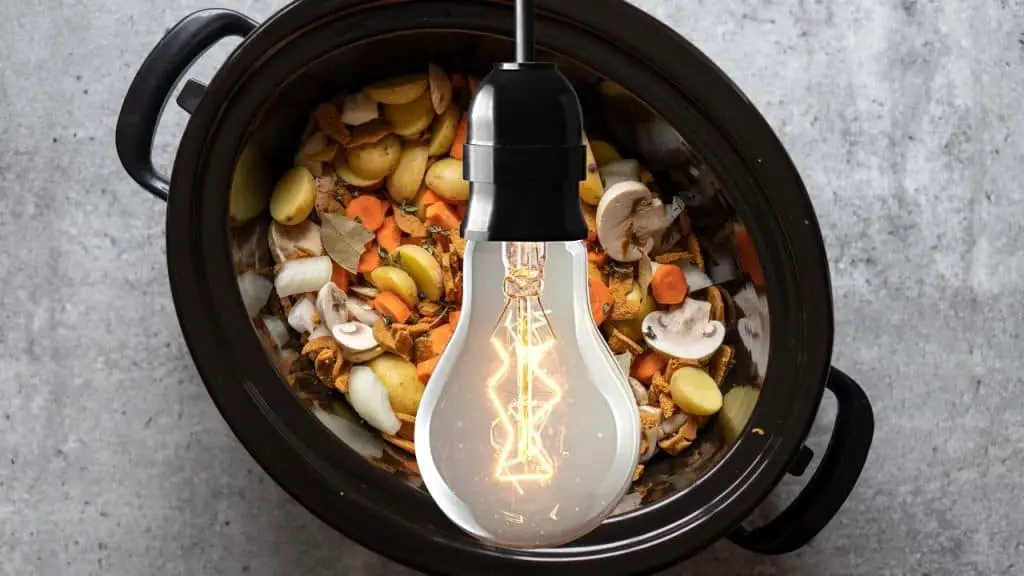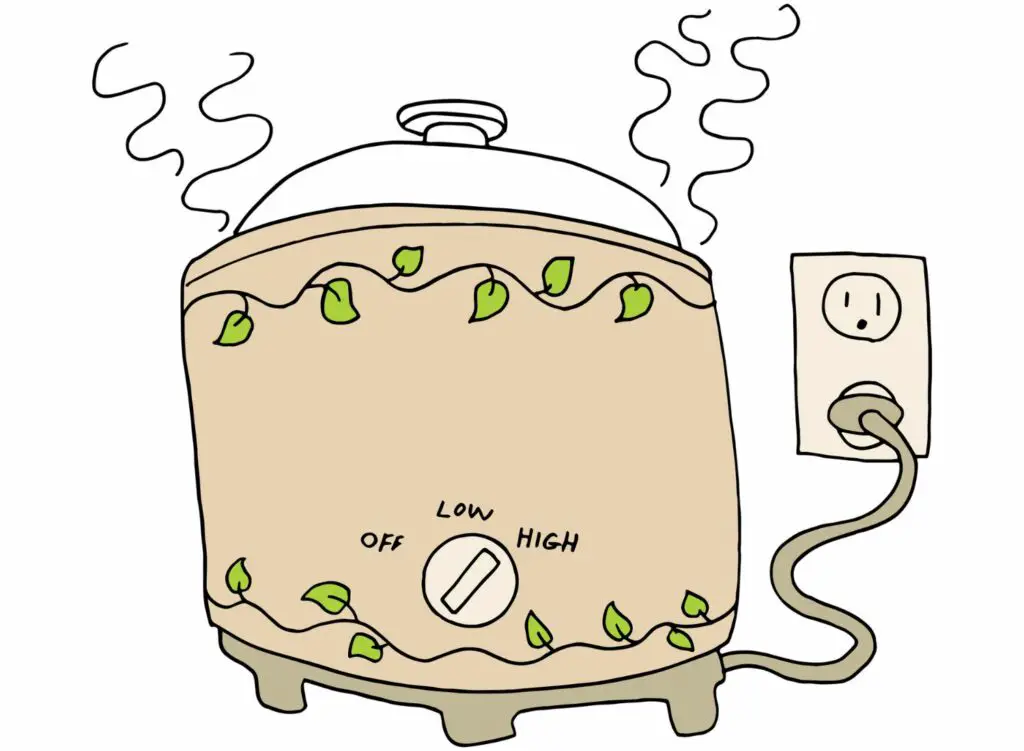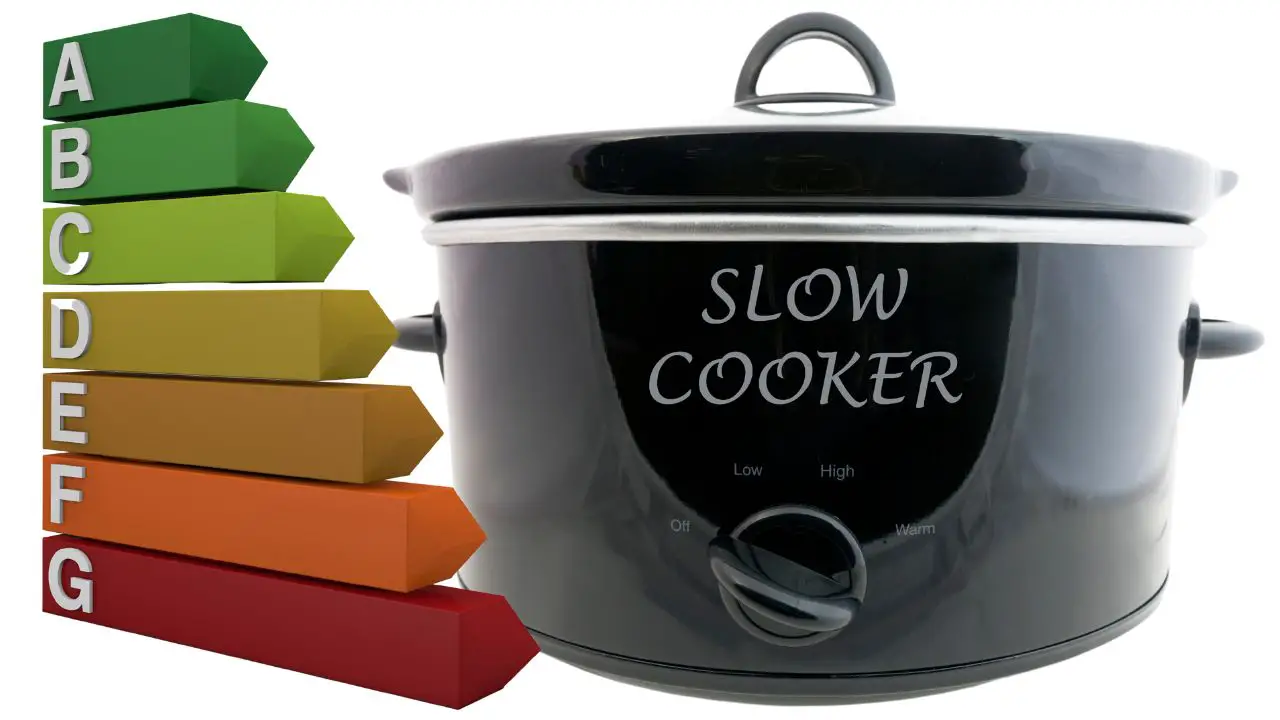Most slow cookers are already very energy efficient and consume more or less the same amount of energy, but I did find this slow cooker that seems to be the most energy efficient slow cooker there is.
Skip to the most energy efficient slow cooker here>>>
In times like these, who isn’t keeping an eye on the bills, right? Especially those pesky electricity ones! So, I’m going to dive into what makes this little gem of a slow cooker shine in the energy-saving department, stack it up against some others, and see how it can keep some extra cash in your pocket.
Understanding the Energy Efficiency of Slow Cookers

Slow cookers stand out from many other kitchen appliances primarily due to their unique method of operation. Their superb energy efficiency is directly linked to their low-temperature, long-duration cooking approach.
Unlike traditional cooking appliances that generate a substantial amount of heat, slow cookers keep the temperature low, thereby consuming significantly less electricity.
Let’s explore this by drawing a comparison with a common kitchen appliance: the electric oven.
Electric ovens, although varying in specifications, typically consume between 2 to 5 kilowatts per hour (kWh). On the other hand, slow cookers have a much lower power requirement, consuming only about 0.075 to 0.21 kilowatts per hour.
This comparison clearly illustrates the immense energy-saving potential of slow cookers. Even after being used for a full 8-hour cycle, a slow cooker will still use significantly less energy than an electric oven operating for just a single hour.
In essence, slow cookers offer the benefits of prolonged, low-temperature cooking, resulting in lower energy consumption and, consequently, reduced utility bills.
However, it is important to remember that the efficiency can vary between different slow cooker models. Therefore, it’s essential to choose wisely for the best environmental and economic benefits.
Learn More Here: Slow Cooker Energy Consumption (Must Read for Budget-Conscious Foodies).
Key Factors Contributing to a Slow Cooker’s Energy Efficiency
If you’re considering buying an energy-efficient slow cooker, there are two factors you need to keep in mind: slow cooker size and cooking temperature.
Size

The bigger the capacity of a slow cooker, the more energy it consumes. Of course, this means that personal slow cookers of just 1.5 quarts (1.4 l) meant for one or two people will consume less energy than larger ones meant for a bigger family.
However, these numbers can be a bit tricky.
For example, a small 1.5-quart slow cooker can consume 0.40 kWh, while a 7-quart option (6.6 l) can be 0.8 kWh. At first glance, the smaller slow cooker is the most energy-efficient, but the larger one can cook much more food with far less power.
Of course, the size of your slow cooker should always fit your lifestyle. If you live alone and cook daily, a smaller device is your best bet. However, a larger one could be perfect for a family or someone who cooks ahead of time.
Temperature
With higher heat, you need more power and thus consume more energy.
All slow cookers come with temperature settings ranging from warm to low to hot, and even the most energy-efficient option will cost you a bit more than estimated if you use it in the high heat setting all time.
However, even in such cases, it will be more energy-efficient than your regular electric oven or most other cooking appliances—just keep that in mind!
Ready? This Is The Most Energy-Efficient Slow Cooker I Have Found!

As you know by now, the most energy-efficient slow cooker is always one that adjusts to your needs. I mean, there’s no sense in buying an extra-large appliance if you live alone at home, right?
So, let’s assume you do not live alone and have to cook for approximately four to four to six people. You like to have leftovers to make things easier for the future and also can cook in low heat settings over many hours.
TAP ON IMAGE TO VIEW PRICE
If this sounds like you, then the most energy-efficient slow cooker you can find on Amazon is the Crock-Pot 6-Quart Cook & Carry Programmable Slow Cooker that you can see above.
What Is The Energy Consumption Of This Slow Cooker?
It all comes down to the wattage. According to the makers, the device works at 240 Watts. That means that you consume 0.24 kilowatts each hour. If you cook for approximately 8 hours, that would mean a total of 1,92 kW.
What it means in money terms depends on where you live.
On average, each kWh costs 23 cents in the United States, while in the United Kingdom, it is 34p. That means that across eight hours of cooking with this Crock-Pot slow cooker, you’d spend 44,16 cents in the United States and 65,28p in the United Kingdom. All for a meal of 4-6 people!
Read Also: Is It Safe To Leave Slow Cooker On Overnight?
How Does It Stand Against The Competition?
Smaller slow cookers, such as the popular Elite Gourmet MST-250XS Electric Slow Cooker Ceramic Pot, have impressive numbers—after all, it works on only 120 watts, which translates to 0.12 kWh.
TAP ON IMAGE TO VIEW PRICE
Sure, if you live alone and only cook for yourself daily, it’s an excellent option, as it has a capacity of 1.5 quarts. But keep in mind that it consumes exactly half the amount of power the Crock-Pot Cook & Carry above while cooking three times less food.
That means that, regarding quantity and energy efficiency, the larger Crock-Pot wins—if you cooked the same amount of food with both devices, you would consume more energy using the small Elite Gourmet slow cooker.
Compared to slow cookers of similar capacities, the Crock-Pot Cook & Carry also wins by a landslide.
This fellow 6-quart set by Hamilton Beach is one of the best-sellers on Amazon, and it consumes 340 watts, which translates to 0.34 kWh. Meaning? Using it for eight hours will cost 62,56 cents or 92,48 p in electricity—almost £1.
See the price difference? Suppose you use your slow cooker once a week for a year—approximately 52 weeks. In that case, Americans would spend $22,9 a year with the Crock-Pot Cook & Carry, while the Hamilton Beach means $32,5. In the United Kingdom, the difference goes from £33,9 with the Crock-Pot to £48 a year.
Quite a big difference, huh?
What Are The Pros Of This Most Energy Efficient Slow Cooker?

Your priority so far is energy efficiency, but that doesn’t mean you have to stick with a terrible crockpot.
Luckily, the Crock-Pot Cook & Carry Slow Cooker above has plenty of features that make your meals more than just green-friendly for the environment and your pockets.
TAP ON IMAGE TO VIEW PRICE
- A digital control panel that helps you program any cooking time range—from 30 minutes to 20 hours.
- Automatic shift into warm setting once the timer reaches zero, keeping food warm and toasty.
- Features a locking lid with a rubber gasket to guarantee a super-strong, anti-spilling seal and to keep all the heat in.
- Easy to carry, store, and move around.
- Dishwasher-safe to make cleaning a breeze.
What Are The Cons Of This Slow Cooker?
Of course, nothing is perfect! Even if the Crock-Pot Cook & Carry Slow Cooker is energy-efficient and a fantastic device, it does have its fair share of downsides worth considering.
- When I was using it, I noticed it ran a bit too hot with some meals. And It is not just me; many reviewers complain that the Keep Warm setting can sometimes reach up to 209°F (98°C). Interestingly, it does not seem to affect the energy efficacy of this appliance, or perhaps it could be even more economical if
- What I also did not like was the moisture accumulation under the handle on the top.
- Also, in my opinion, the cord is a bit short, which limits maneuverability in my kitchen.
In Conclusion
Selecting the most energy efficient slow cooker is a savvy choice for those mindful of their budget. These cooking appliances, characterized by their optimal power consumption, size adaptability, and regulated temperature settings, can bring about significant savings on your energy bills, especially;y if you use a low cooker as often as I do.
Through slow, low-heat cooking, they demonstrate that enjoying delicious meals doesn’t have to be costly. Essentially, adopting energy-efficient cooking can result in both flavorful dishes and healthier finances.
Related Article: What Is Black Garlic And How To Make It – Slow Cooker Vs. Fermenter.
Related Video: My Slow Cooker Is Cooking Up Comfort, But at What Cost?



